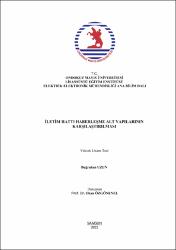İletim hattı üzerinden haberleşme yöntemlerinin karşılaştırılması
Künye
Uzun, B. (2021). İletim hattı üzerinden haberleşme yöntemlerinin karşılaştırılmas. (Yüksek lisans tezi). Ondokuz Mayıs Üniversitesi, Samsun.Özet
Günümüzde, geçmişe kıyasla insan sayısının ve ihtiyaçlarının artması dolaylı yoldan enerji kullanımını yani tüketimini de artırmıştır. Tüketiciyi iletim hatları üzerinden enerji ile buluşturmak, bu enerjinin sürekliliği ve tüketicinin can güvenliği çok önemlidir. Kullanılan sistemler çok büyük ve birbirine bağlı sistemler olduğu için hataların ortaya çıkma olasılığı da bir o kadar fazladır. Bu hatalara kurulu sistemlerin verdiği cevaplar hem insan sağlığı hem enerji sürekliliğini sağlamak adına çok önemlidir. Hataların önüne hızlı bir şekilde geçme isteği iletişim ve bilgi gönderme ihtiyacını ortaya çıkarmıştır. Bu tezde iletim hattı haberleşme yöntemleri karşılaştırılarak, daha üstün olan haberleşme yöntemi araştırılmıştır. İHH yöntemi ile kablosuz haberleşme yöntemleri artıları ve eksileri karşılaştırılmıştır. Haberleşme yöntemi olarak İHH seçildikten sonra iletim hattı üzerinden bilgi iletimi olumsuz etkileri olan gürültü, kanal empedansı ve işaret zayıflaması sorunları irdelenmiştir. OSOS, SCADA, PRIME ve G3 uygulamaları karşılaştırılmıştır. İletim hattı haberleşmesi için uygun olabilecek bindirim yöntemleri karşılaştırılmıştır. İletim hattı haberleşme sistemi benzetimi 2FKA metodu ile tasarlanmıştır. İletim hattı üzerinden iletilen 50Hz sıklığa sahip şebeke işaretine kıyasla çok yüksek sıklıklarda olan taşıyıcı işaret 2FKA işareti ile bindirime uğramıştır. İletilmek istenen bilgi işareti, iletim hattı üzerinden 2FKA bindirimi ile gönderilmiştir. İletim hattı çıkışında ise ayrıştırma işlemi uygulanarak girişteki bilgi işareti, çıkışta okunmuştur. İletim hattı boyunca giriş bilgi işareti, taşıyıcı işaretleri ve iletim hattı çıkışındaki bilgi işareti sonuçları PSIM programı ile gerçeklenmiştir. Bilgi işaretinin giriş ve çıkış PSIM sonuçları tezde yer almaktadır. Böylece iletim hattı üzerinden haberleşme işlemi sağlanmıştır. Today, the development of technology and the increase in the number of people, the industrialization and the needs of people increase the importance of electricity consumption and thus the importance of transmission lines. It is very important to bring the consumer with energy through transmission lines, the continuity of this energy and the safety of the consumer. Since the systems used are very large and interconnected, the likelihood of errors is as high. And the response given by these systems is very important both for human health and to ensure energy continuity. The wish to quickly avoid mistakes has brought about the need to communicate and send information. In this thesis, better advantageous communication method is investigated by comparing powerline communication methods. Pros and cons of PLC method and wireless communication methods are compared. After choosing PLC as the communication method, noise, channel impedance and signal weakening problems that have negative effects of data transmission over the transmission line are examined. OSOS, SCADA, PRIME, G3 methods were compared. Modulation methods that may be suitable for transmission line communication are compared. Transmission line communication system simulation is designed with BPSK modulation method. The carrier signal, which is at very high frequencies compared to the 50Hz frequency network signal transmitted over the transmission line, is modulated with the BPSK signal. The information signal to be transmitted is sent via BPSK modulation over the transmission line. At the transmission line output, the demodulation process is applied and the information signal at the input is read at the output. Input information signal, carrier signal and output information signal were carried out on PSIM program along the powerline. Input and output PSIM figure of data signals are included in this thesis. Thus, communication process is provided over the transmission line.
















